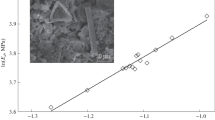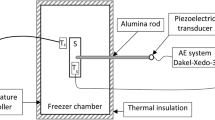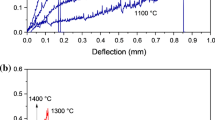Abstract
In this paper the results of indirect tensile tests on highly porous ceramics are presented. A relation between the mechanical strength of the highly porous ceramic materials and Acoustic Emission (AE) has been established. We have shown that the amplitude distribution of the AE events depends on the crack velocity, which itself depends on the stress intensity of the crack. Apart from the Brazilian (side crushing strength) tests also multi-point loading experiments were carried out. The AE results show the additional damage accumulation due to compressive/shear stresses.
Similar content being viewed by others
References
J. C. Charmet, S. Roux and E. Guyon, “Disorder and Fracture” (Plenum Press, 1990).
S. Roux, “Probabilities and Materials” (Kluwer Press, 1994) 163–75.
E. Guyon, S. Roux, A. Hansen, D. Bideau, J. P. Troadec and H. Crapo, Reports on Progress in Physics 53(4) (1990) 374–419.
L. J. Gibson and M. F. Ashby, “Cellular Solids: Structure and Properties” (Pergamon, 1988).
P. J. F. Wright, Magazine of Concrete Research, July (1955) 87.
P. M. Duxbury and P. T. Leath, J. Physics A 20 (1987) L411.
I. C. van den Born, Mechanical strength of highly porous ceramics, Ph.D. thesis University of Groningen, 1992.
I. C. Van Den Born, A. Santen, H. D. Hoekstra and J. TH. M. de Hosson, Phys. Rev. B 43 (1991) 3794.
Y. Higo and H. Inaba, The general problems of AE sensors, Acoustic emission: current practice and furture directions, ASTM STP 1077.
A. A. Pollock, Non destructive testing, October (1973) 264.
ASTM Designation E976-84, “Standard Guide for Determining the Reproducability of Acoustic Emission Sensor Response,” Philadelphia, 1984.
B. Gutenberg and C. F. Richter, Bull. Seismol. Soc. Am. 32 (1942) 163.
C. G. Hatton, I. G. Main and P. G. Meredith, J. Struct. Geol. 15 (1993) 12, 1485.
P. Diodati, F. Marchesoni and S. Piazza, Phys. Rev. Lett. 17 (1991) 67, 2239.
J.K. Atkinson, J. Geophys. Res. 89 (1984) 4077.
T. Yamashita and L. Knopoff, Geophys. J. Roy. Astr. Soc. 96 (1989) 14.
L. Knopoff, in “Disorder and Fracture,” edited by J. C. Charmet, S. Roux and E. Guyon (Plenum Press, New York, 1990) p. 289.
L.B. Freund, “Dynamic Fracture Mechanics” (Cambridge University Press, 1993).
O. Vardar and I. Finnie, Int. J. Fracture 11 (1975) 495.
E. U. Okoroafor and R. Hill, J. Mater. Sci. 30 (1995) 4233.
Author information
Authors and Affiliations
Corresponding author
Rights and permissions
About this article
Cite this article
Aué, J., de Hosson, J.T.M. A study of the mechanical properties of highly porous ceramics using acoustic emission. Journal of Materials Science 33, 5455–5462 (1998). https://doi.org/10.1023/A:1004470905641
Issue Date:
DOI: https://doi.org/10.1023/A:1004470905641




